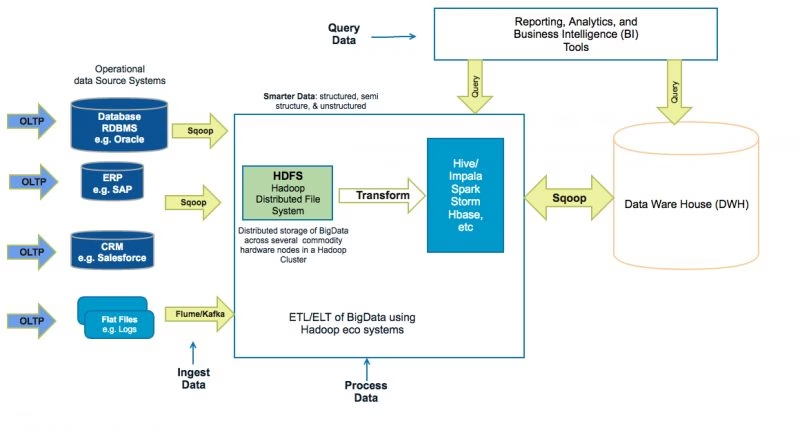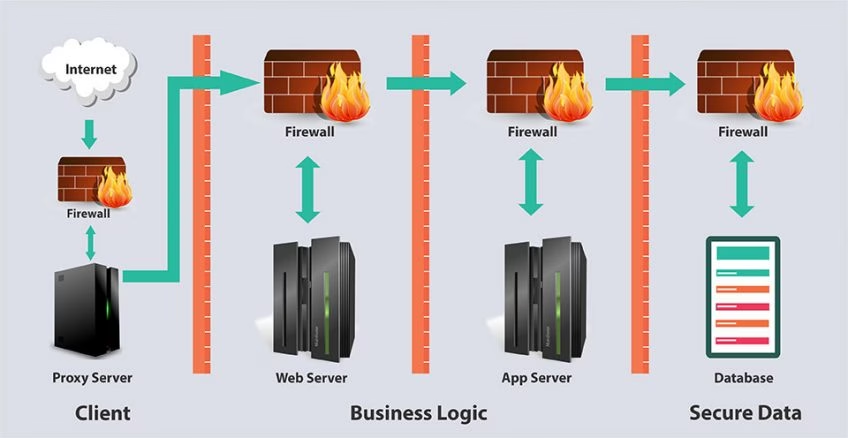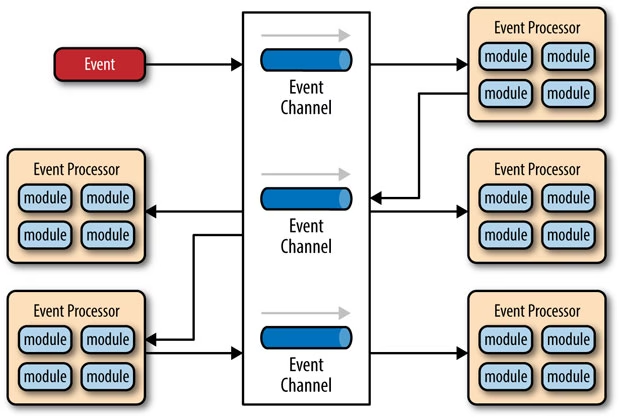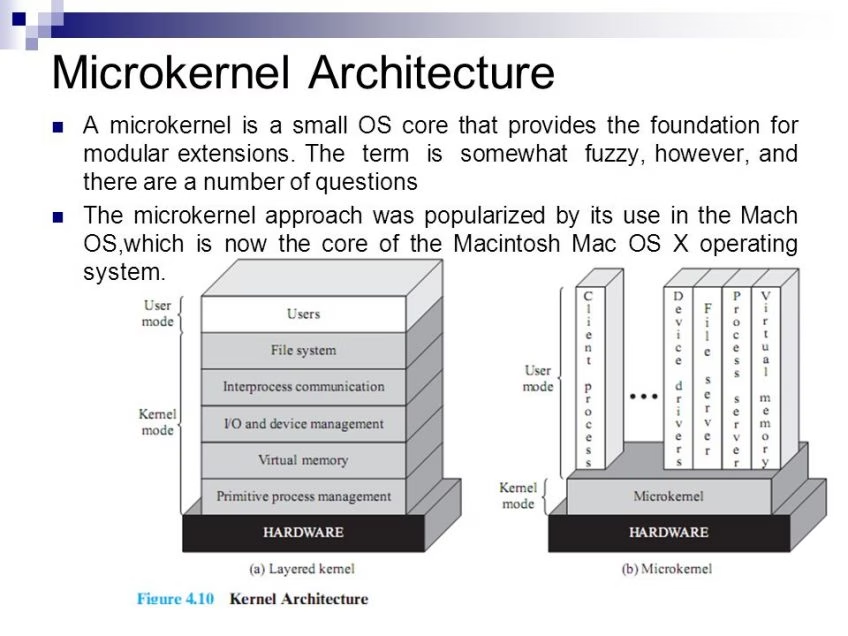
Java Application Architecture — What Are the Best Options for Enterprises
Wondering about the best large enterprise Java application architecture? You've come to the right place.
Good application architecture is essential if you plan to build a first-class application that is bound to scale a big time.
Do you remember the old mainframe days? Users would enter data in the dumb terminals, and those terminals weren't capable of anything else. All processing would happen in the Mainframe.
In comparison, today Netflix accounts for 31% of the North American Internet traffic and is heavily reliant on microservices. We have indeed come a long way!
The advent of Java, arguably one of the most powerful programming languages ever, has changed the enterprise application development landscape completely.
While Java with its rich array of features lets the enterprise get its job done in a variety of ways, concerns of maintainability, manageability, and the need to have many releases throughout the year have prompted the project teams to create various architectural models for the enterprise projects.
In this article, I will describe the five most popular Java app architectures the enterprise of today uses, with their pros and cons. After reading this article, you'll be able to figure out which architecture is best for Java in your particular case.
Layered (n-tier) architecture: the most common enterprise Java application architecture

Today‘s enterprises have been storing their data using large ’relational database management systems‘ (RDBMS) and tables in these databases have a massive amount of corporate data. The layered architecture is the most common today because it's built around data stored in these tables.
As you know, many of today's Java enterprise apps are built using famous frameworks like Jakarta Enterprise Edition (Jakarta EE), Drupal, and Express. These platforms themselves follow this layered architecture, and as a result, the applications follow this model too.
This enterprise Java applications architecture is designed so that the data enters the very top layer. The data then flows through the other layers, and finally reaches the database at the bottom of the layers.
The different layers can, and usually do, have different tasks. One layer may check the data for consistency, and another may reformat the values to maintain a common standard in the application.
The Java developers have adopted this architecture in a significant manner, for example, most web frameworks employ the ’Model-View-Controller' (MVC) structure as a standard development approach.
MVC is an example of layered Java app architecture. It‘s common to find programmers experienced in specific layers, and teams organized according to the layers.
How does MVC work? The model layer sits just on top of the database and has the business logic. It also contains information about the kind of data the database holds.
The view layer is at the top with possibly CSS, JavaScript, and HTML code. The controller is in the middle containing the various rules for transforming data traversing between the model and the view.
There are both pros and cons to a layered architecture. Following are some of the advantages:
- It allows the project team the ’separation of concerns‘, i.e. each of the layers can concentrate on its role only. This architecture is hence easy to maintain and testing is easier. The project team can easily assign separate ’roles‘, and individual layers can be enhanced separately.
- If the architect has properly separated the layers, then changes in one will not affect another layer. This makes it easy to execute projects requiring changes only to some specific functionalities.
- Additional open layers can be created, for example, a ’service layer‘, and access can be customized.
Although it is the most common architecture, there can also be several difficulties in managing it. For e.g.:
- The architect must do a really good job of segregating tasks for different layers.
- If the programmers don‘t code factoring the separate roles according to the layer, the program can become a very unorganized one.
- A significant portion of code is devoted to passing data between layers and has no other business logic. The overall program can become slow.
- An architect joining the project team later will find it difficult to understand the architecture because of so many layers and will need to read all programs.
- If good coordination in the team is absent, a developer can code skipping layers. This creates a program with complex interdependencies that becomes hard to maintain.
- Depending on the effectiveness of the implementation, this architecture may need a complete redeployment of the application even due to small changes.
This is suitable for the following scenarios:
- A new app must be built and deployed quickly;
- Business apps that need to conform to the traditional IT department practices;
- The project team is inexperienced and understands only this model;
- The maintainability requirements are stringent, and testing should be easy in the future.
Event-driven architecture for enterprise Java application architecture projects: For the apps that wait on data

You have seen apps that are active only when there‘s data for processing, and inert at other times. Many web apps waiting for human interaction are good examples, however, in the world of networking also, there are applications that wait for data to arrive.
In the event-driven architecture model, there is one central agent that accepts the input data. This architecture has separate modules for different functions, and the central agent directs the data to an appropriate module.
The word ’event' in the name refers to this handoff.
Take the example of a website that uses JavaScript. The mouse clicks and keystrokes by the user are events. In this case, the browser performs the role of the central agent. It collates all data inputs, even in the forms of mouse clicks or keystrokes, and sends a form of data only to the module that deals with that kind.
The modules will be inert if the input ’event‘ is not in their functional area, although the user may continue to input different kinds of data in the browser. This is the main difference with the layered architecture where all data must pass through all layers.
The advantages of the event-driven architecture are the following:
- It's suitable for chaotic environments, it adapts well to complexity.
- This model is highly scalable.
- When the app needs new functionalities, thus generating new kinds of events, this architecture can be easily extended to cover the new events.
There are also different complexities in this module system model, and the programmers, when architect modular software, must take care of them. For example:
- If there are interdependent modules, then while the individual modules can be tested easily, testing the interactions between separate modules requires a fully functioning test environment.
- There are instances when different modules must handle the same event. In such cases, error handling requires complex programming.
- The project team must design fall-back options for the central agent, in case individual modules catering to certain events experience a failure.
- Some of the apps may have activities only in bursts. It's possible that inputs arrive in bursts, and the central agent must have a mechanism for buffering messages. The developers must factor this in, and it's an overhead, which can slow down the app.
- This architecture requires a high volume of upfront work on the part of the data modelers and database designers. The events vary, and they have different needs. Accordingly, the modules deal with different kinds of data, hence the data modelers have their task cut out when they aim to create a data structure for the entire app.
- The modules in this architecture are independent of each other, and it‘s hard to maintain a consistent transaction-based mechanism.
This architecture is best for apps with UIs, e.g. web apps. Also, apps involving individual data blocks interacting only with selected modules should use this architecture.
Microkernel architecture: One for high-usage tools

A microkernel is a small OS core that provides the foundation for modular extensions. The term is somewhat fuzzy, however, and there are a number of questions.
The microkernel approach was popularized by its use in the MacOS, which is now the core of the Macintosh Mac OS X operating system.
If you are a Java programmer, you have used the Eclipse integrated development environment (IDE), and so have I. All Java developers have used it, and it‘s a tool famous for doing a lot of routine tasks all by itself without the user even prompting it.
You have seen how Eclipse opens the files, annotates those, and edits the files while starting the background processor. Once the developers are done with the coding, they can click a button to compile their code.
Eclipse uses a microkernel where all the routines for these basic repetitive operations are stored.
Note that the Java compiler isn‘t part of the microkernel, rather it‘s just a bolt-on, running on top of the eclipse. You could take Eclipse and use it to code programs in other languages, and in such cases, you will not use the Java compiler. However, you will use the basic routines.
In the microkernel architecture, basic routines are executed as part of the kernel. The other features may vary depending on the business the app is used for, and the project teams can just code them as bolt-on routines on top of the kernel. This is also called ’plug-in architecture'.
The advantages are obvious. This is used in tools with heavy usage because it simplifies the common operations.
However, the developers using it as their Java application structure to design modular software systems need to follow these best practices:
- Determine carefully what the microkernel holds. It should only hold code that‘s frequently used.
- The plug-ins on top should have handshaking code so that the microkernel knows that those are ready to work.
- When several plug-ins have been installed and they all depend on the microkernel, it's very hard to modify the microkernel independently. Often the plug-ins will need modifications, too.
- When working with this architecture, the project team should have adequate expertise to decide the granularity of the kernel upfront. It‘s nearly impossible to change it later.
In addition to high-usage tools, this architecture is also good for apps with a fixed set of core tasks, because the dynamic set of tasks can be accomplished using bolt-on routines and those can be modified frequently.
Microservices architecture: Build many small programs instead of a giant one

Look at the Netflix UI. The various interfaces, for example, to list your favorites, accounting information, and the ratings you gave to films, etc. are all different services. You can think of the Netflix website as one seamless collection of many smaller websites.
The company uses microservices architecture.
This architecture allows the Java developers to build many smaller programs for different services, instead of having to build one giant program that does it all. A new feature will also require one new small program.
There are similarities with the event-driven or the microkernel architecture, however, in the case of the microservices architecture, the different tasks are truly separated.
The demands for the different services are different, and the enterprise can run them from separate servers and scale up or down according to the demand.
For enterprises with heavy consumer demands, this represents a significant advantage. For example, Netflix runs its content delivery and other tracking services on different servers. It helps them with scaling, and with 31% of the North American Internet traffic coming to them, they certainly need to scale.
There are important factors to consider when implementing the microservices architecture, e.g.:
- The services should be independent of each other.
- This isn‘t suitable for apps where tasks can‘t be fully separated.
- If a task is spread out between different microservices then performance may be sub-optimal.
- A webpage with too many microservices may give an appearance to the user that some parts of the site are loading slower, and it can be confusing.
This architecture is good for websites with small separate components, or new web apps requiring rapid development of parts.
Space-based architecture: to address the high load on the database
Websites built around a database function well when the database works well. However, under exacting conditions of high load, the database can fail, and it may not be able to keep writing a log for every transaction. Along with the database, the website also fails.
To address this issue, the enterprise architects have come up with the concept of space-based architecture, where the processing logic, as well as the database, is partitioned into multiple servers. Individual horizontal shards of the database can function much better, and the web app benefits as well.
This enterprise architecture uses all ’in-memory‘ objects, and storing the information in RAM makes the app faster. This, while partitioning the storage and processing, makes for a simplification. This is also called ’cloud architecture‘.
However, there are the following disadvantages:
- Computing operations spread out the entire database, e.g. a statistical analysis involving the entire data can become more complex. Such processes must be broken down into ’sub jobs‘, distributed, and then finally aggregated.
- Database loaded into RAM makes transaction support harder.
- Testing the entire system is harder since enough load must be generated.
- There are multiple nodes, and hence multiple copies of data. In this circumstance, caching the data is harder, due to the risk of corrupting the data.
This is good for high-volume, but low-value, data. Social networks can make good use of this enterprise architecture. However, as I have mentioned, there are difficulties with developing good and safe caching, and data may occasionally be lost. This architecture is certainly not for the banks!
Key considerations while choosing a software architecture pattern
We just talked about the most popular software architecture patterns. However, choosing a pattern for your project can be hard. You need to consider several aspects. The following are a few examples of such considerations and questions:
1. The Java project ideas that you are evaluating
The type of project significantly influences your choice of architecture pattern. You might develop an Android app. On the other hand, you might plan to build an app like Netflix.
You might use the clean architecture pattern for an Android app. In the other case, you will likely choose the microservices architecture pattern. Carefully analyze your requirements.
2. Java application architecture patterns for creating a tutorial
Are you creating a tutorial that Java programmers can use? Perhaps you are targeting final-year students of information technology major? Students at this stage are learning Java skills, and they don’t have professional experience.
Such a beginner would benefit from a simple Java application architecture, e.g., a basic web application, simple web pages, etc. At this point, a programmer is just learning Java hands-on.
He/she would focus on coding functional Java programs. Learners would concentrate on learning core Java, object-oriented programming, how the Java bytecode works, etc. More than becoming the best Java programmer, the focus is on learning the intricacies and features of the language.
You should choose the layered architecture for such a project. This allows for comprehensive learning opportunities. The learner can learn the “Object-Oriented Programming System” (OOPS) in detail.
3. The importance of choosing the right architecture for high-demand systems like ATM
Not all software systems are the same, and some have very high demands. ATM systems are good examples of them.
ATM networks and the associated software applications must meet high availability, reliability, performance, and scalability requirements. They must also respond to user requests on a real-time basis. Choosing the right architecture pattern is the key for you to meet these “non-functional requirements” (NFRs).
4. Finding the right architecture pattern for high-visibility systems like a billing system
Some application software systems must deliver their functionality with a very high degree of accuracy. At the same time, they must meet stringent NFRs. The high-visibility nature of these systems mandates that. A good example is a billing system in an enterprise like a telecommunications company.
If you are a software architect planning to design the architecture of such a system, study industry best practices carefully.
An example is how Oracle has designed the architecture of its “Billing and Revenue Management” (BRM) solution. Oracle has designed a four-tiered architecture with tiers like application, business process, data management, and data.
5. Choosing the architecture pattern for systems with seasonal demands, e.g., an airline reservation system
Are you building a system with seasonal peaks in demand, e.g., an airline reservation system? Such a system should scale sufficiently to handle the higher demand during peak seasons. This requires appropriate infrastructural capacity planning, however, it requires choosing the right architecture too.
6. Offering complex features and special capabilities in a system
Do you plan to build an application system with complex features? Are you using cutting-edge technologies like “Artificial Intelligence” (AI), “Machine Learning” (ML), “Internet of Things” (IoT), etc.?
Perhaps your project involves creating ML algorithms using Python? Alternatively, you might need to use complex analytics capabilities with MySQL.
To take another example, you might be creating a system with complex security requirements. E.g., you need to implement “multi-factor authentication” (MFA) for authenticating a user ID.
Such complex systems require great maintainability and supportability. Your choice of the architecture pattern makes a big difference in meeting such NFRs.
7. Documenting software architectural decisions
We all know the importance of documenting functional requirements and NFRs. You will surely take appropriate measures to document the “Software Requirements Specifications” (SRS) effectively. You will likely document all key user interface design parameters clearly.
Well, you need to document your software architectural decisions carefully too. Developers and testers will use them as key inputs to their work.
E.g., will you use open-source software? To take another example, what are the performance testing requirements? A well-written software architecture document helps the development and testing teams significantly.
The importance of skills and experience when implementing Java application architecture pattern
You chose a software architecture pattern. Now, the time has come to implement it effectively. You need a competent development team with the right skills.
The skill requirements will vary according to your Java application architecture project. E.g., you might need developers with great skills in the following:
- Servlets;
- JSP;
- Netbeans;
- API development;
- PHP;
- Encapsulation;
- JDBC;
- Linux;
Keep an eye on maintainability too. Developers should provide useful comments in the source code, which helps the maintenance team to understand the code.
Learn more about examples of Java application architecture.
You will need competent Java developers with a thorough understanding of various Java application architectures in your software development teams to launch a software application successfully.
You can find such expert Java developers in the software developers community at DevTeam.Space. Moreover, you can easily partner with these software developers for your next large enterprise Java application architecture project by sending your initial specifications via this form.
One of our dedicated account managers will get back to you for further assistance.
Further Reading
Here are a few articles that might also interest you:
How To Build A Distributed Computer Solution - DevTeam.Space
How to Build a Crypto Portfolio Tracker App? I DevTeam.Space
How to Build a Business App Like Indeed Job Search? I DevTeam.Space
How to Build a Boxing App? DevTeam.Space
Frequently Asked Questions on Java Application Architecture
It is a map or flow graph of all the main elements in a project. It is designed to give a clear representation of how they interact with each other.
The software development project architecture design consists of the following steps:
• Define the project
• Gain a clear understanding of the project
• Define its strengths and weaknesses
• Map it out
• Shapes
• Lines
• Curves & Spirals
• Angles
• Symmetry
• Color
• Contrast
• Pattern


